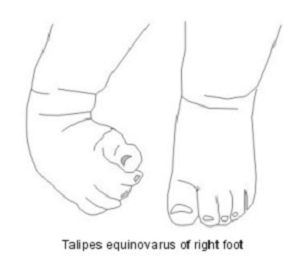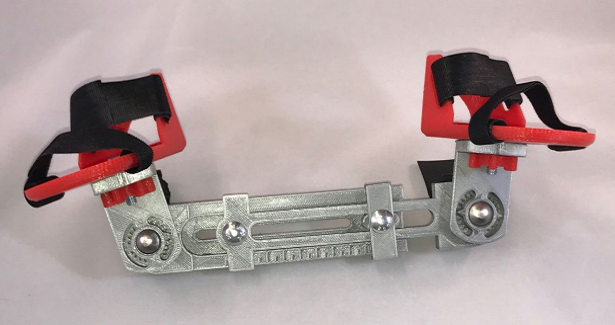However, 3D printing, which has been used in the past to help treat CTEV, can help democratize the manufacture of these FAOs for more sustainable development, in addition to bringing the cost down. A new paper, titled “Open-Source Three-Dimensional Printable Infant Clubfoot Brace,” was recently published in the Journal of Prosthetics and Orthotics by a team of researchers, including open source advocate Dr. Joshua Pearce, from Michigan Technological University (MTU).
The researchers explain that inexpensive, open source RepRap 3D printers have helped expand access to the technology, while also keeping costs down.
“To investigate the potential of distributed manufacturing of an FAO for clubfoot patients in the developing world, this study makes a careful investigation of the use of RepRap 3-D printers to fabricate an open-source clubfoot brace,” the researchers wrote.
“The methodology includes first selecting among the various commercial 3-D printing materials based on material properties and cost, developing an open-source design using only open-source tools, and describing the open-source 3-D printer used and the settings to fabricate the clubfoot brace. Then, the brace’s features were examined to ensure that it met the required features for foot abduction orthoses designed for treating clubfoot. Finally, this brace was then examined by doing a cost and functionality comparison with existing designs.”
The team designed their 3D printable clubfoot brace using free, open source FreeCAD software, in order to “enable customization.” The design was optimized for easy printing, with minimal overhangs, and was “created with the intent of being able to meet criteria collected from the literature.” The most important features in the brace are:
- the ability to maintain foot positioning in order to prevent relapses
- the ability to adjust the angle of abduction
- the ability to dorsiflex the feet
Additionally, by making sure the width of the FAO between the feet is adjustable, the brace will need to be replaced less, thus making it more cost-effective.
“The ability of the foot pads to move independently and attach and detach from the abduction bar increases comfort and encourages proper usage,” the researchers explained.
Due to its strength and low cost, the researchers chose to 3D print the brace, and its 13 assembly components, out of biodegradable PLA. Cura software was used to slice the CAD models, and the brace was printed, at a speed of 40 mm/second, on a MOST delta RepRap 3D printer with an infill density of 80%, 0.2 mm layer height, and a 1 mm shell thickness.
Then the team ran a cost analysis on the three main variables – labor, filament, and electricity – that would drive the cost of manufacturing the brace locally in Kenya, where CTEV is “especially prevalent.” Labor costs in the country varied from $0 for volunteers, or employees who simply monitor the 3D printer and assemble the brace, up to the government-dictated wage of $1.30/hour for a Kenyan machinist in an urban area. Three commercial filament sources are available, while electricity costs run from $0/kWh for running a solar-powered 3D printer to $0.2029/kWh – the highest standardized rate for electricity in Kenya based on data from January of 2017.
The researchers found that the total material cost of the clubfoot brace was $11.08. However, it should be noted that the variable with the most potential to effect the overall cost is the labor, though electricity and filament costs can also vary.
The base of the FAO consists of top and bottom sliders held together by two carriage bolts, a closing bracket, and two nuts. By loosening and tightening the knobs, the feet width of the brace can be adjusted for a growing child.
Attachment of the footpads to the assembly via angle brackets with interlocking ridges to lock footpads into place.
“Due to the simplicity of the assembly, the infant’s shoes can be first attached to the footpad via Velcro straps before attaching the footpad to the bar,” the researchers explained. “The shoes employed should be “low rise” at the heel to allow observation that the heel remains against the foot pad, which is lost if a “high top” shoe is employed.”
This FAO offers more functionality at lower cost, and also has a lower environmental impact, as it only requires a partial infill and no shipping is required when it’s 3D printed locally. The team made the STL files and FreeCAD models for its infant clubfoot brace available for free at the Open Science Framework under a GNU General Public License 3.0.
The researchers concluded, “The results show that the open-source clubfoot brace matches or surpasses the physical features and mechanical degrees of freedom of all commercial- and non-profit-developed brace designs while substantially reducing the costs of the braces to hospitals and families.”
Subscribe to Our Email Newsletter
Stay up-to-date on all the latest news from the 3D printing industry and receive information and offers from third party vendors.
You May Also Like
3D Printing Unpeeled: New Arkema Material for HP, Saddle and Macro MEMS
A new Arkema material for MJF is said to reduce costs per part by up to 25% and have an 85% reusability ratio. HP 3D HR PA 12 S has been...
3D Printing News Briefs, January 20, 2024: FDM, LPBF, Underwater 3D Printer, Racing, & More
We’re starting off with a process certification in today’s 3D Printing News Briefs, and then moving on to research about solute trapping, laser powder bed fusion, and then moving on...
3D Printing Webinar and Event Roundup: December 3, 2023
We’ve got plenty of events and webinars coming up for you this week! Quickparts is having a Manufacturing Roadshow, America Makes is holding a Member Town Hall, Stratafest makes two...
Formnext 2023 Day Three: Slam Dunk
I’m high—high on trade show. I’ve met numerous new faces and reconnected with old friends, creating an absolutely wonderful atmosphere. The excitement is palpable over several emerging developments. The high...




































